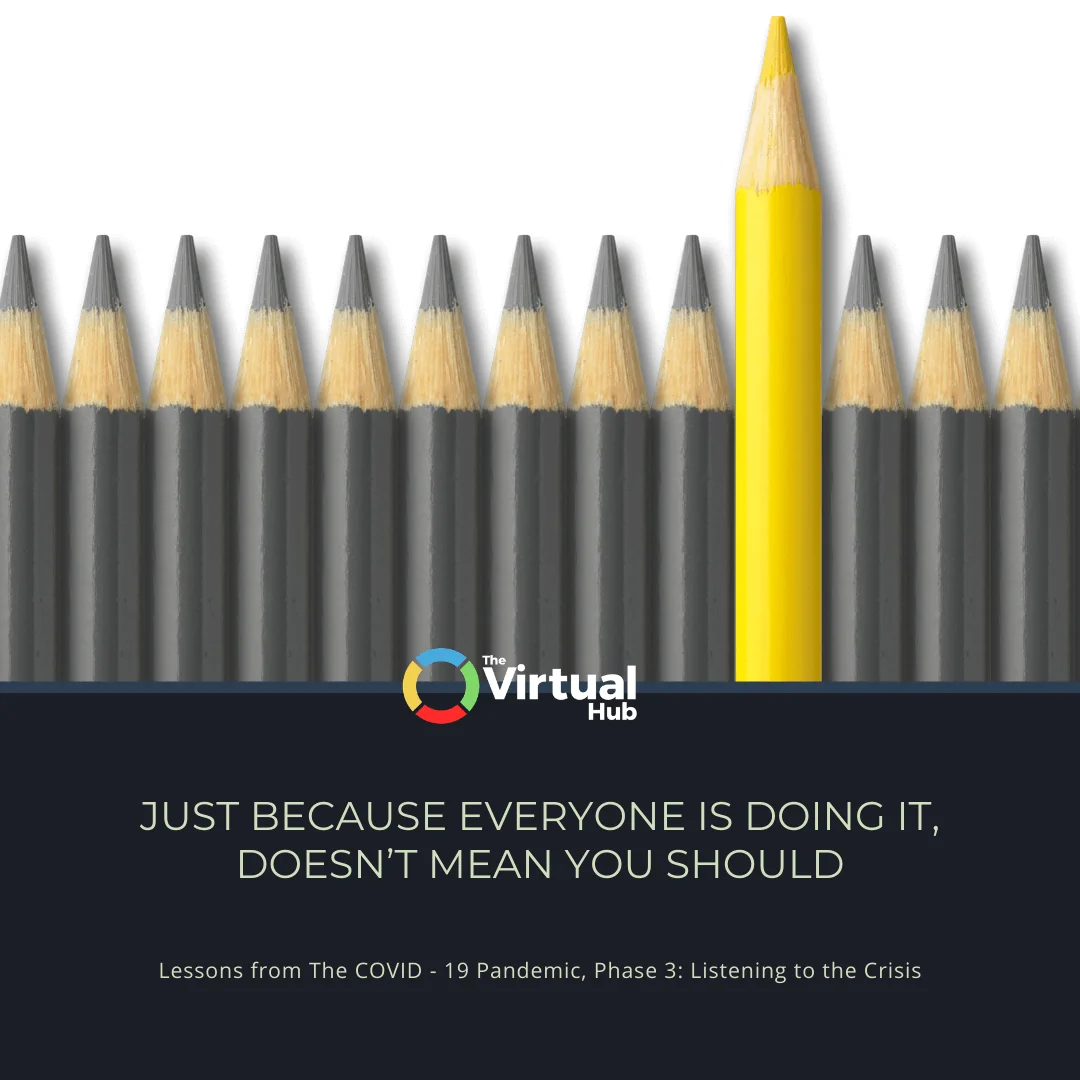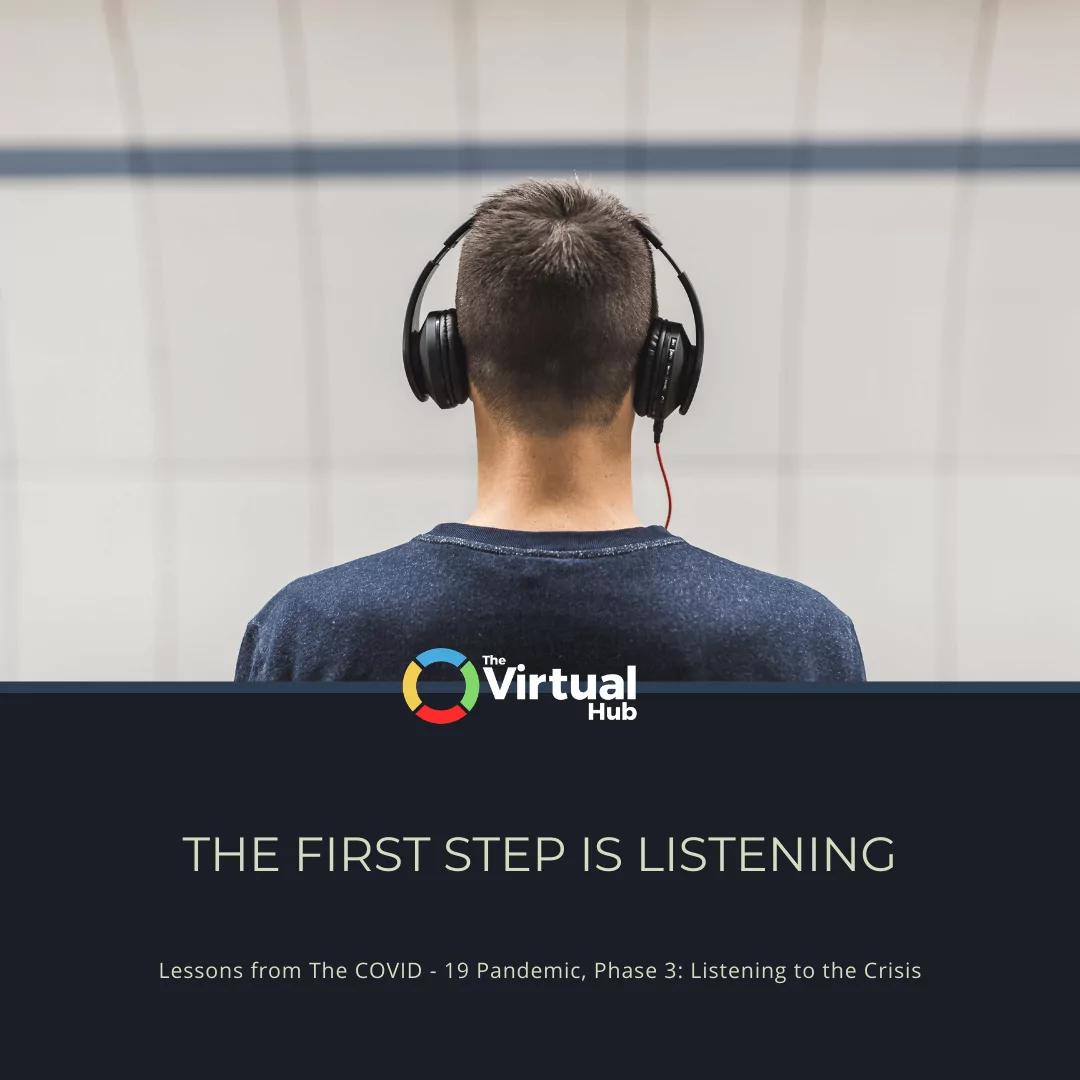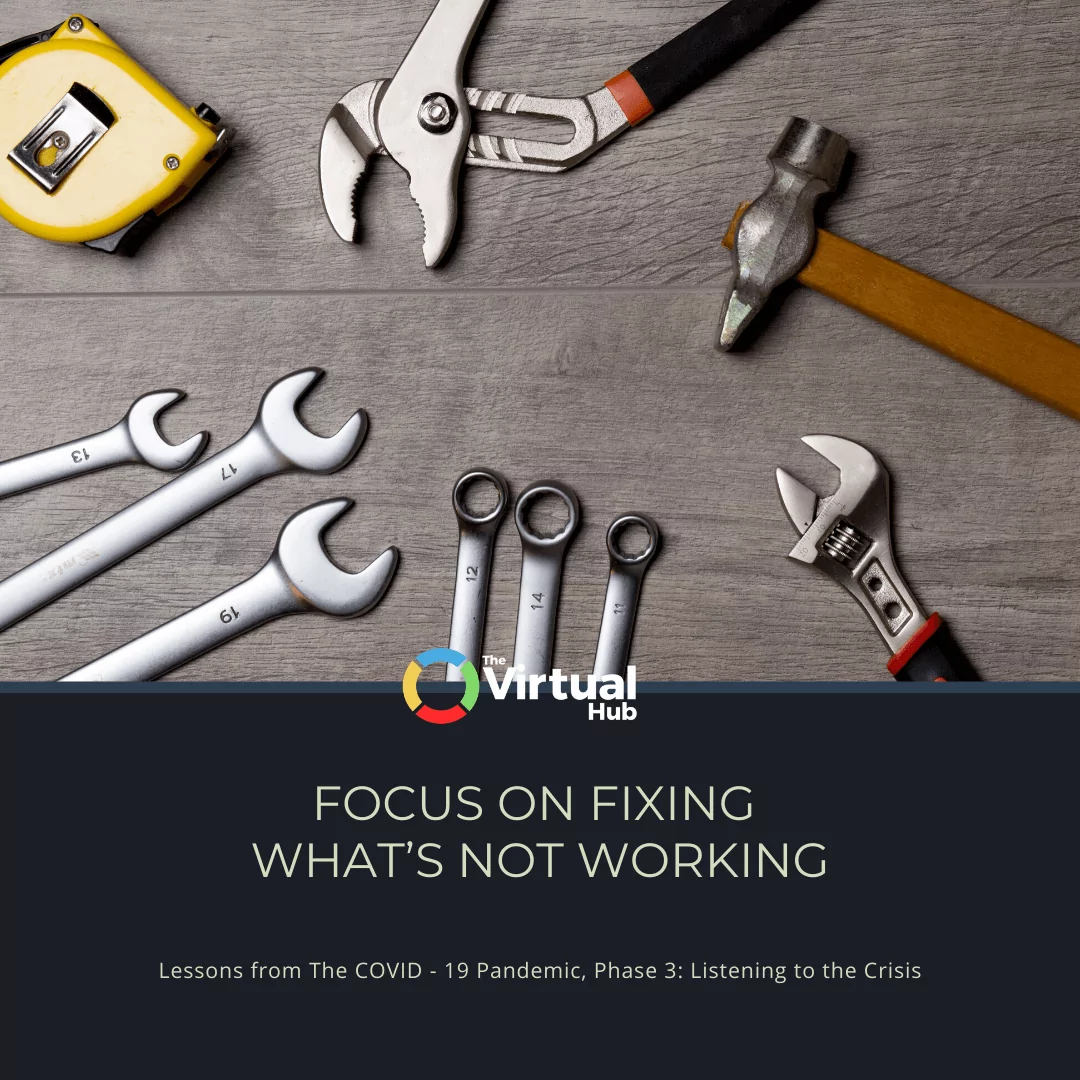Authored by: Barbara Turley, CEO - The Virtual Hub
PIVOT?
Oh, wait … maybe not. Actually no let’s do it …
Surprise!
We’ve been talking about the need for businesses to pivot in order to survive this crisis. And then it turns out that we’re not so sure….
In our last post, part 2 of this crisis management series, I talked about the need to deliberately shift from the panicked, adrenaline-rush, crisis management mindset to a more strategic, somewhat grounded and level headed one. Survival mode can save your ass initially, but you can’t create and innovate from a crisis survival mindset.
I also shared the endless questions that had been keeping me up at night trying to figure out a pivot. What’s going to work now, where the opportunities will be, and how to develop and implement a plan to pivot.
In fact, I wrapped part 2 of this series with a promise to tell you about the pivot we came up with for The Virtual Hub and how we’d launch and market it, only to turn around a few weeks later and realise we didn’t need to pivot at all!
When the crisis first hit, we had clients cancel or pull back on our services, leaving us with quite a lot of excess capacity. I felt an incredible sense of urgency and responsibility about it because I feared we would end up with a lot of employees and not enough work (or money) to go around.
I was adamantly digging my heels in and determined not to let anyone go. I wanted to meet payroll for everyone no matter what.
The pivot plan was to pull those VAs with excess capacity into a team dedicated to one-off project launch packages. In fact, we went as far as creating a landing page to offer and promote this new service to the market. The whole thing was planned, built and ready to go.

We set out to launch it and then tell you in this piece how we came up with it and how the launch went.
But guess what?
I couldn’t pull the trigger!
Why? Well, the short answer is that something in my intuition, my gut, was stopping me from launching it. Every day, I found myself putting it off until “tomorrow.” At first, I didn’t know why I was hesitating. I just knew I couldn’t do it. So instead of telling you about our pivot plan and its launch this week, I’m sharing why we didn’t implement it and what I’ve realized since the last entry in this series.
For A World That’s “Standing Still,” It’s Pretty Damn Noisy
The whole world is physically kind of frozen in place, and zillions of articles have been published about how the pandemic has forced us all to slow down. And because we’ve been mostly stuck at home, it’s barely an exaggeration to say that everyone with WiFi and a device is online all the time.
Besides comforting ourselves with too much ice cream and wine (just me?), being online, for business or pleasure, is one of the few things left to do.
So, although we may not be physically moving much, our heads are going at lightning speed trying to process information, including the rapid-fire of all the “how-tos” and directives coming at us in an endless stream. (As if we weren’t on information overload before this all started!)
Obviously, the “need” to pivot your business to adapt to this landscape is one piece of advice that seems to pop up endlessly – it’s a big part of what we’ve been talking about here! And as entrepreneurs, we’re always ready to push on and push ahead.
We take action. And we do it now, right?

But I’ve come to realize that “pivoting” is becoming a buzzword, and something we should heed with the age-old advice from mothers everywhere: Just because everyone is doing it, doesn’t mean you should.
So, how do you know if you should pivot in your business? I’ve come to believe that the first step is listening.
Listen Up To Determine Your Next Move
As I said above, I didn’t at first know why I didn’t go ahead with the pivot offering of project-based services. But listening to my gut turned out to be the right decision.
After the first few weeks of the stay in place orders, everyone was still reeling a bit, but the initial shock was starting to wear off. As business owners adapted to more remote working conditions, trained, cost-effective virtual team members started to become even more appealing.
So, now we’re running out of virtual assistants as we try to keep up with the demand for virtual work that this crisis has shoved us into!
I realized over the past few weeks that our core offer still stands. In fact, it’s highly appealing in this environment.
Had we pushed ahead and launched the project-based pivot offer, we would now be scrambling to service two different styles of offer with a fast diminishing pool of excess resources.
The pivot, in reality, would have been tricky to get right anyway and, ultimately, very distracting from our core, highly desirable offer of inhouse trained and managed virtual assistants.


Listen To Whom?
The first thing that lead me to the realization that a pivot is not the smart option for us – was listening to my intuition. But the little voice in your head isn’t the only one to tune into.
I certainly wasn’t operating in a total vacuum. I’ve been talking to people who are in the same industry as I am, and to friends, clients, and business owners in different industries.
Doing interview podcasts daily to talk to even more people is another way I have been connecting with more and more people.

The more I talk to people, the more my creativity and my energy is coming back because everyone’s sharing experiences, which help me to connect concepts into new ideas.
But I’m going to tell you the truth. Although I had been tuning in to my own and others’ voices, I wasn’t truly doing it strategically. I thought I was just putting off launching our pivot plan, which was making me fear that I wasn’t reacting fast enough. When I really had the epiphany around what I was doing – pausing before jumping into the pivot – was when I interviewed Jenny Blake for The Virtual Success Show.

The ONLY Move That Matters
The author of Pivot: The Only Move that Matters Is Your Next One and the host of the Pivot with Jenny Blake podcast, Jenny’s consulting business helps individual and organizations map what’s next. Google and CHANEL are among her clients, so I knew she’d have something amazing to share about pivoting right now.
I expected our interview to focus on what to do right now – deciding on a pivot, acting on it, and so on. But I was gobsmacked by the direction the conversation actually took.
Jenny admitted she had an initial “must pivot” reaction when the crisis started because her normal routine involves a lot of keynote speaking and travel, which obviously went right out the window. For a second, she thought about trying to fill her calendar with the coaching work she did while growing her business. But she realized it would be a bridge – a temporary move – and one that didn’t align with her business vision.

She paused before making a decision, which gave her the space to realize coaching wasn’t going to work for her now. When we talked, she thought it was so important to get clear about what you want and what will work for you now, so you choose from a place of excitement rather than fear.
We went on to talk about ways of listening, like simply getting on the phone with more people than you usually do, and giving ourselves permission to pause before reacting. We talked about how the world moves so fast now that it had already been moving toward a place where long-term planning looks different than it used to, anyway. We have to plan more fluidly now and just keep moving forward.
"We have to plan more fluidly now and just keep moving forward. "
The bottom line is that you may or may not need to pivot, and that it’s okay to stop and assess the landscape instead of reacting, even if all the talking heads are telling you pivoting is non negotiable.
Pivot, Ride It Out, Or Double Down?
Fortunately, I figured out that pivoting wasn’t the smartest move for The Virtual Hub before we introduced a new service that would ultimately have taxed our resources and distracted us from our core offering.
Granted, the decision to ‘stay in our lane’ was pretty straight forward for us, given the type of business we’re in and how businesses have been forced to operate right now. Virtual assistant services sync wit h what’s going on right now. I realize that this might not be true for you.
It’s going to be up to you to do your own listening – internally and externally – to figure out what’s best for your business.
If what you offer to the market simply isn’t going to be a thing anymore, when the dust of this pandemic finally settles, you’ll need to make a complete pivot to adjust to the conditions.
This might even include starting over and entering a different market. And that possibility can be quite sobering, but an opportunity to start anew can also be a good thing.


Pivot Continuum
For other businesses, pivoting your entire model might not be necessary, but a mini pivot is needed, such as changing up your messaging or delivery. It’s also possible that your business is only temporarily obsolete and will be something buyers come back for when the world opens up again. You’ll have to determine if there’s anything you can do in the meantime to generate revenue or if you have to find other ways to ride out the storm, like getting a job for the time being.
So, there’s kind of a continuum of pivoting, from “mini" (e.g., adjusting messaging) to “massive” (e.g. an entirely new business model) with lots of options in between (e.g., dropping and/or adding some components of your business). At the same time, you might not really need to pivot at all. I mean, certainly everyone has had to adjust in some way, but a pivot implies a change in direction.
For example, have you tried to buy a game or puzzle lately?
Manufacturers can’t keep up with the demand for jigsaw puzzles – their sales are up nearly 400%! (Which is great for them right now, but they should probably have a plan for scaling back again once people can get together for other activities – a different kind of problem to have.)

Other industries that have no need to pivot but to instead adjust to fast business growth are cleaning services, deliver services, online content (think: both digital products and entertainment), and meal-prep businesses – not to even mention the sale of liquor!
"Be sure to give some attention to what is working and find ways to max it out. "
These businesses don’t need to pivot because they’re still headed in the same direction; they’re just traveling faster.
So, while most businesses need to figure out where they fall along the continuum of possible pivots, most businesses probably need to also focus on doubling down on what’s working for them.
In our case, we hopped off the pivot train, and we were able to double down on the entire business because our core offer makes sense. You may be in the same position as we are, or you may have to listen in and decide what aspects you should pivot and which you should double down on. It’s easy, especially in a crisis, to focus on fixing what’s not working. Be sure to give some attention to what is working and find ways to max it out.

Look Where The Puck Is Headed
No matter what business you’re in, we’re all making adjustments and acting fast to address some very acute issues.
But be sure to take time away from the whirlwind of reacting to the crisis to tune in and listen – to yourself (your “gut), your clients, your team members, your potential clients, your business connections, and so on. And as you do this, be sure to consider what’s working and not working right now but also start to look ahead at what might happen next.
Although no one really knows what to expect, we can be sure that it’s not going to stay the way it is now.
Things will gradually open up, more and more over time. We need to be prepared for that, as well. At some point, we need to start placing some bets on where markets are heading and plan for those possibilities.
